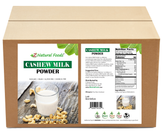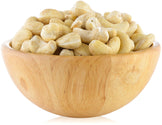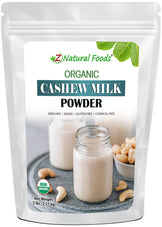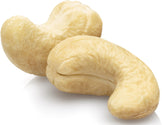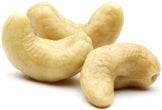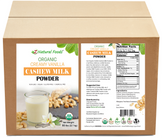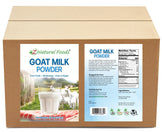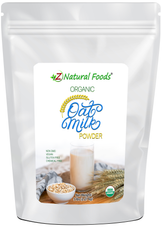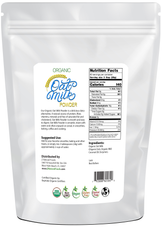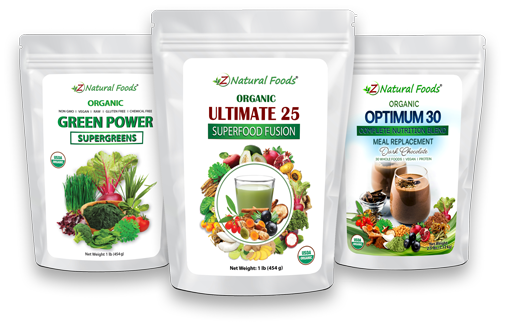Description
Description
If you have ever wondered what the nutritional differences are between coconut milk powder and whole milk powder, you have come to the right place.
In this article, we review the nutritional content of coconut milk and whole milk and look at the protein, fats, and other nutrients in each.
Coconut milk powder vs. whole milk powder (nutrition compared)
The nutrition contained in whole milk is shown to be highly complex and provides the body with great nourishment, including a unique blend of fast (whey) and slow-digesting (casein) proteins. Alternatively, while the coconut is not a source of protein, modern medical science discovered coconut’s healing powers largely come from its unique fatty acid breakdown.
Every culture defines how and why an individual food is considered “healthy” based on various factors.
According to Western medicine, healthy food is a substance that provides the nourishment needed to sustain well-being and retain energy.
On the other hand, Traditional Chinese Medicine (TCM) looks at food from a slightly different perspective. According to TCM, food is not defined as healthy or unhealthy but, instead, if it is the right food for an individual at a specific time.
Good health is defined as the absence of illness and a well-rounded state of physical, mental, and social well-being.
Health is influenced by many factors like genetics, behavior, environmental and biological influences, and social factors. All of these influences are affected by daily habits that may profoundly affect well-being and longevity.
While hydration, movement, sleep, having outlets, and finding purpose are essential, our food choices for nourishing our bodies are vital. While the basic standards for what is considered a healthy food often come down to whether it has essential nutrients to sustain life, here at Z natural foods, we like to take it up a notch. We consider healthy foods as getting a well-rounded superior level of nourishment that allows you to thrive and not just survive.
Therefore, comparing foods for their nourishing qualities should be based on three criteria:
- What they have in common
- What makes them different
- Are they the right choice for your individual needs
With that, let’s now review these two incredible foods.
Nourishing fats compared; milk fat vs coconut fat
Milk Fat
For a long time, it was believed that all fats are created equal and your dietary fat intake should be minimal to be healthy.
Well, modern-day science and research have entirely debunked this theory.
What we know as an indisputable fact is that all nourishing food-based fats have wonderfully unique qualities that may support optimal well-being and longevity when consumed in a balanced manner.
- Nutritious fats are necessary for a quality diet for various reasons like possibly supporting healthy balanced hormones, brain, and heart health.
- They are also a nourishing source of essential fat-soluble vitamins (A, D, & K).
- Diets low in nutritious fats have been linked to vitamin deficiencies, hair loss, weakened immune response, and a host of other issues.
The fats contained in whole dairy are shown to be highly complex and provide the body with great nourishment
Although milk fat is often not consumed as an isolated food, it has been given a bad wrap.
As more food science emerges, we understand the wide range of components contained in milk, like essential vitamins, minerals, high-quality protein, and a wide range of fatty acids.
Therefore, how these fats in milk function in the body take on a new meaning.
According to a review titled Composition, structure, and absorption of milk lipids: a source of energy, fat-soluble nutrients, and bioactive molecules,
“Milkfat is not only a source of bioactive lipid components but it also serves as an important delivery medium for nutrients, including the fat-soluble vitamins ... milkfat's composition, functions, and biological properties will need to be re-evaluated as the food marketplace moves increasingly towards more personalized diets.”
The breakdown of fatty acids in whole milk:
- 62% Saturated
- 30% Monounsaturated
- 4% Polyunsaturated
- 4% Transfats
What's the story behind transfats in milk fat?
Did you know that not all Trans Fatty Acids (TFA) are created equal?
There are two major types of transfats in the food supply:
- Industrial: Formed by partial hydrogenation of vegetable oils
- Natural occurring: Trans fatty acids in milk and meat that biohydrogenation ruminant animals create (R-TFA).
Here is an interesting evaluation of the impact that ruminant Trans Fatty Acids may have on human health…
Naturally occurring trans fatty acids include vaccenic acid, the main TFA in dairy, and rumenic acid, the biologically active form of CLA (conjugated linoleic acid). In a review titled Evaluation of the Impact of Ruminant Trans Fatty Acids on Human Health: Important Aspects to Consider,
In simple terms, Ruminant Trans Fatty Acids (R-TFA) from whole milk offer natural qualities that the dangerous and non-nourishing partially hydrogenated industrial fats don’t come close to competing with.
One of the natural components of R-TFAs is Conjugated Linoleic acids (CLA) which have been associated with the prevention of allergies and asthma.
Because there is still much to be learned about R-TFAs, we are not explicitly encouraging you to consume an isolated and concentrated form of them. Please note the potential nourishing qualities of R-TFA’s are not acquired as isolated substances but as a part of the whole food complex where all other natural compounds and constituents are present.
For example, if CLA were not present, it would potentially change the quality benefits of these nourishing fatty acids.
This is why at Z Natural Foods, we encourage the consumption of products (whether concentrated or not) that present the whole food complex.
Coconut Fat
The Coconut Research Center explains, “The vast majority of fats and oils in our diets, whether saturated or unsaturated or come from animals or plants, are composed of long-chain fatty acids (LCFA).”
All fatty acids share the same basic structures;
- One carboxyl group is attached to a chain of carbon atoms.
- Long-chain fatty acids have 13-21 carbon atoms in their tails.
- Some 98 to 100% of all the fatty acids you consume are LCFA."
Coconut is known to have MCFA or medium-chain fatty acids, also called MCT or medium-chain triglycerides containing 6-12 carbon atoms.
MCFA are metabolized by the human body differently because of their size. They are rapidly broken down and go straight to the liver, where they are used as an instant energy source or turned into ketones.
Ketones are created when insufficient sugar or glucose supplies the body’s fuel needs. Unlike the saturated and unsaturated fats in vegetable oils, eggs, milk, and meats, which contain LCFA, coconut is a rare dietary source of MCFA and, therefore, highly beneficial to the body and overall health.
For more information about our MCT Oil powder, go here: MCT Oil Powder.
Only recently has modern medical science unlocked the secrets to coconut’s unique healing powers.
Coconut’s fatty acid breakdown:
- Lauric Acid C-12:0 (49%)
- Caprylic Acid C-8:0 (8%)
- Caprylic Acid C-10:0 (7%)
- Myristic Acid C-14:0 (8%)
- Palmitic Acid C-16:0 (8%)
- Stearic Acid C-18:0 (2%)
- Oleic Acid C-18:1 (6%)
- Linoleic Acid C-18:2 (2%)
According to an article titled The properties of Lauric acid and their significance in coconut oil, “the primary fatty acid of coconut oil is lauric acid, which is present at approximately 45–53 %. The metabolic and physiological properties of lauric acid account for many of the properties of coconut oil. Coconut oil is rapidly metabolized because it is easily absorbed, and lauric acid is easily transported.
Detailed studies have shown that most ingested lauric acid is transported directly to the liver, where it is converted to energy and other metabolites rather than stored as fat.
Such metabolites include ketone bodies, which can be used by extrahepatic tissues, such as the brain and heart, as a quick form of energy. Studies on the effect of lauric acid on serum cholesterol are contradictory. Among saturated fatty acids, lauric acid has been shown to contribute the least to fat accumulation.”
Protein in whole milk powder: It does the body good.
Many foods provide us with nourishing amounts of quality protein; each is unique in its own right.
While the coconut is not a source of protein, one of the many nutritional qualities of whole milk is that it offers a unique blend of fast (whey) and slow-digesting (casein) proteins, allowing for maximal use of this essential macronutrient.
According to an article in the National Library of Medicine titled, Health-Related Aspects of Milk Proteins, “Casein and whey protein are the major proteins of milk. Casein constitutes approximately 80% of the total protein in bovine milk, and whey protein accounts for about 20%. Casein is chiefly phosphate-conjugated and mainly consists of phosphate-micelle complexes. It is a heterogeneous family of 4 major components: alpha (As1 & 2 casein), beta-, gamma-, and kappa-casein.”
“Whey protein is a collector of globular proteins with a high level of a-helix structure. The acidic basic and hydrophobic-hydrophilic amino acids are distributed in fairly balanced form. Alpha-Lactalbumin and beta-lactoglobulin are the predominant whey proteins. Among other types of whey proteins, immunoglobulins, serum albumin, lactoferrin, lactoperoxidase, and protease-peptones must be mentioned.”
Cottage cheese is a curdled milk product containing high amounts of curds and whey.
Many athletes like Bill Star, author of The Strongest Shall Survive, discuss the importance of eating cottage cheese for athletes and those with muscle-wasting conditions multiple times daily, including one of those servings before bed to support muscle recovery. It is an excellent source of casein (a slow-digesting protein), a great source of highly bioavailable protein, and high-quality fats.
So, what is best – Coconut milk or whole milk?
In conclusion, the answer to this important question is a matter of your goals and your preferences.
If you like the taste of whole milk and your body does well on it, this is certainly a time-tested and proven option.
Alternatively, coconut milk is an excellent alternative to whole milk, concerning texture and consistency.
If we are going to answer this question based on nourishing qualities, consider what each of these fantastic foods brings to the table for your individual needs.
Either way, whole milk, and coconut milk are both wonderful, nourishing foods with unique qualities and attributes, providing your body with essential nourishment to support a healthy lifestyle.
For more information about Whole Milk Powder and Coconut Milk Powder, you are invited to review these resources:
- What is whole milk powder? (+Nutrition profile)
- Is coconut milk powder the same as coconut milk? (Explained)
- Powdered coconut milk nutrition facts (+micronutrients)
- Common questions about coconut milk powder (10 Faqs)
To review all of our Milk & Cream powders, including Whole Milk Powder, Organic Coconut Milk Powder, Goat Milk Powder, a range of Cashew Milk Powders, Oat Milk Powders, and more, go here:







